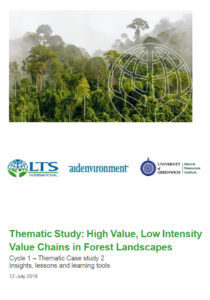This thematic study conducted by the Partnerships for Forests (P4F) Evaluation Manager (NIRAS-LTS International) sought to answer the following question: ‘To what extent and how can high value, low intensity (HVLI) value chains create sufficiently strong incentives for sustainable forestry and associated land use practices, via increasing productivity and producer incomes, rather than deforestation and land degradation’.
This report presents key insights and lessons emerging from a literature review on this theme, the learning tools which have been developed based upon these findings, and the results of the pilot testing of a project assessment framework for seven selected Partnerships for Forests (P4F) projects.
The focus of the literature review was on identifying evidence on the impact pathway, i.e. P4F interventions and capacity building leading to producer and community benefits as well as positive ecological impacts of non-timber forest products (NTFP) commercialization processes. Most of the relevant literature is focused on NTFP, which is relevant for this study because these products are also characterised by their high value end markets, while at the same time they are found and can be harvested at a low density within forest landscapes and can act as an incentive to add value to the standing forest. In this way they may de-incentivize alternative land uses causing forest degradation or deforestation. The review generated a substantial amount of documentation on NTFP benefits for producers and harvesters, gender issues, community interests and benefits, and on the role of producer organization and capacity building.
There is less documentation on value chain issues, the incubation of producer-controlled processing and different forms of community-company partnerships, and very limited information on the ecological effects of commercialization initiatives in specific products, particularly evidence on wider ecological impacts (apart from anecdotal evidence). Lastly, some information was found on land tenure issues and NTFPs, but there was limited analysis of other enabling environment issues, such as the role of multi-stakeholder platforms, economic measures or spatial plans in HVLI value chain development.
Key insights emerging from this literature review are summarised in the main report. These findings formed the basis for an assessment framework, which was used to assess to what extent the key issues identified are addressed within a selection of P4F projects. Pilot testing of this tool was supported by a P4F representative, who facilitated interactions with two regional teams. This generated initial insights in how key issues were covered by the P4F projects and/or by its partners, and what challenges were less covered.
The report was completed in July 2018 to aid adaptive programming by P4F. The report is presented here for context and to share findings and aid learning by others working in the same area as P4F.

